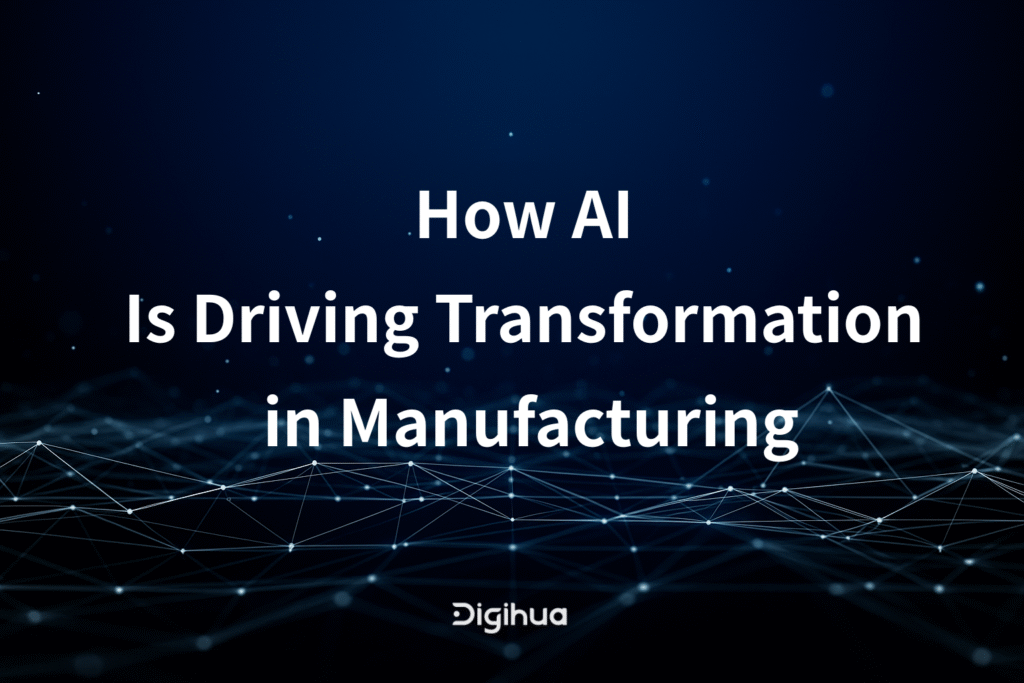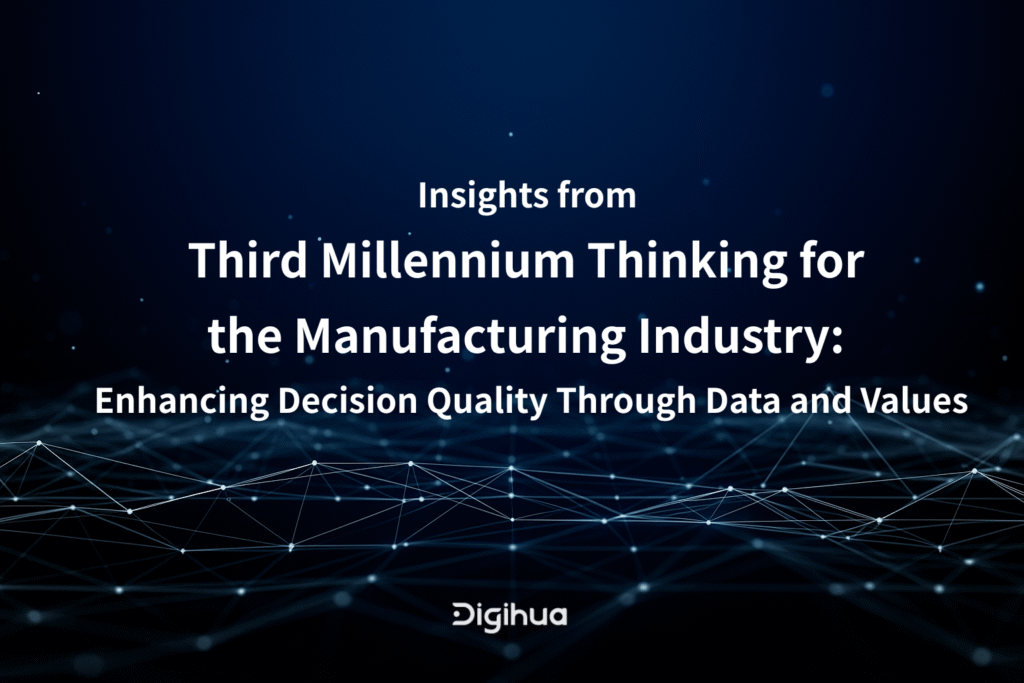 Preface|From Data Governance to Partnership: The Next Step for AI in the Factory
Preface|From Data Governance to Partnership: The Next Step for AI in the Factory
In our previous two articles, we explored two key questions:
In “How AI Is Driving Transformation in Manufacturing” and “Insights from Third Millennium Thinking for the Manufacturing Industry: Enhancing Decision Quality Through Data and Values”, we focused on the first steps of practical AI implementation, as well as the foundation of data reliability and human-AI consensus.
Together, these pieces revealed a critical trend: AI is no longer just a tool—it’s becoming part of the organizational decision-making process.
And that raises a new question:
When AI evolves from a simple query tool to a system that can respond, learn, and even cover your blind spots during decision-making—how do we work with it? Can such an AI become more than an assistant—can it become a trusted colleague, a true partner?
So we begin with this question: What makes a good partner?
From there, we’ll step into real manufacturing environments to see, step by step, how AI Agents are transforming from support tools into co-creators of decision resilience on the factory floor.
Summary
As generative AI sweeps across the manufacturing floor, the real question is no longer whether AI can be adopted but whether AI can truly participate in decision-making.
Starting with the idea of what makes a good partner, we conducted qualitative research to categorize fast-growing factories and uncovered a shared mechanism grounded in psychological safety, openness, and shared goals. We then embedded these three conditions into our APS product, redefining the role of AI agents in manufacturing — not just as tools, but as trustworthy partners in decision-making.
Through real-world APS applications, we illustrate how AI can contribute to scheduling adjustments, anomaly responses, and cross-functional collaboration. We also confront the common obstacles: fragmented data, semantic confusion, and resistance from frontline personnel.
Ultimately, we believe AI’s greatest contribution to manufacturing teams is not just improved efficiency, but greater resilience in the face of uncertainty.
This is a practical guide for plant supervisors, system advocates, and future decision-makers. Join us in exploring this question: In times of change, who will be your most trusted partner?
Contents
- 1. What Makes a Good Partner?
- 2. When AI Becomes More Than a Tool — A Co-Creation Partner
- 3. What Does It Feel Like to Work With AI? From Distance to Daily Habit
- 4. What Kind of Decisions Can AI Help You Make? Insights from the Factory Floor
- 5. Common Roadblocks When Adopting AI—and How to Solve Them
- 6. Human-AI Collaboration: The Foundation of a Resilient Decision-Making Team
- 7. What Comes Next?
1. What Makes a Good Partner?
We visited 30 factories and interviewed over 500 employees. What we found was striking: in a manufacturing environment, the most trusted person is not necessarily the one with the highest rank or the most experience. It’s the person who steps in when it matters most—the one who has your back.
A true partner doesn’t blame you for making a mistake; they quietly help manage the consequences. They’ll look up data when the system throws an error, flag risks when you overlook something, and help you rework a production schedule under tight deadlines. This isn’t about skill—it’s about attitude, trust, and shared understanding.
After analyzing our interviews, we discovered that many fast-growing factories share a common cultural mechanism built on three key traits:
- Psychological safety: People aren’t afraid to make mistakes or speak up. Even newcomers feel safe to voice concerns.
- Willingness to share vulnerability: Team members can admit “I don’t know” or “I need help,” which fosters real connection and mutual support.
- Clarity of purpose: Everyone knows what they’re working toward, which aligns actions and keeps the team focused.
These may sound like soft cultural traits, but in reality, they’re the underlying logic that drives team efficiency.
Picture this: when a line supervisor realizes production is falling behind, psychological safety means he’ll report the issue right away instead of hiding it. If team members are willing to share their weak spots, they can catch each other’s mistakes and offer support. And if everyone understands that “on-time delivery and quality control” are the top priorities, the team won’t waste time on blame or confusion.
In simple terms, a great partner is someone who can spot problems with you, face them with you, and solve them with you.
But such partners aren’t easy to find—especially as manufacturing environments grow more complex. With volatile schedules, aging equipment, leaner staffing, fragmented orders, and tighter deadlines, it’s increasingly difficult for any one person to juggle data, systems, judgment, and collaboration.
As AI adoption picks up, teams have started asking: if a true partner is someone who can step in, be trusted, and co-create—could that partner be an AI?
This sparked deeper reflection within our team. We began to explore the potential and challenges of AI Agents in team collaboration and broke down real-world use cases showing how AI can evolve from tool to trusted co-decision-maker.
So now we ask: can the AI Agent become a true partner in factory decision-making?
2. When AI Becomes More Than a Tool — A Co-Creation Partner
In the past, we treated AI as just another tool. But now, in an era of severe labor shortages, we’ve started asking a new question: can AI become a true partner?
The term “AI” has been used in manufacturing for over a decade. But if we’re being honest, most factories still associate it with automated reports, smart analytics modules, or perhaps a feature hidden somewhere in an MES or APS system. It can calculate, it can run — but it’s rarely treated as a system that can “communicate” or truly participate.
That’s beginning to change. The concept of the AI Agent is emerging — not as a feature extension or a black-box algorithm, but as a digital partner in decision-making: one that can talk, contribute, and understand context.
What is an AI Agent?
An AI Agent is an intelligent system capable of learning continuously, interacting through natural language, and offering context-aware recommendations. Its core capabilities include:
- Semantic understanding: Not just matching keywords, but grasping why you’re asking a question in the first place.
- Real-time decision reasoning: Able to synthesize multiple data sources and deliver timely suggestions or options.
- Continuous learning and correction: It remembers your feedback and improves its responses over time.
- Cross-system integration: It connects with APS, MES, QMS, and other platforms to aggregate data and support decisions.
If this sounds like a very capable assistant — you’re right. But it’s more than just a helper that looks up information. It’s a partner that can talk through options with you and proactively flag potential risks.
What can an AI Agent do in manufacturing?
Reduce decision time
No more digging through layers of reports, comparing values, or checking parameters manually. Just ask: “Are any of the three production lines underperforming today?” The AI Agent pulls historical benchmarks, real-time metrics, and exception records to give you a clear answer and follow-up suggestions.
Improve cross-functional collaboration
Sales, engineering, and scheduling teams often look at different reports and speak different “languages.” An AI Agent acts as a shared communication bridge, helping explain the logic behind scheduling decisions and even simulating how decisions look from different departmental perspectives.
Build organizational memory and decision context
Every decision — whether a success or a mistake — can be logged along with its conditions and response patterns. Over time, this builds up a knowledge base that becomes your company’s own internal expert.
Respond to market shifts and fragmented orders
Adjust strategies quickly, without gut-feel guesses. Use real-time simulations and historical analogs to improve the speed and accuracy of response.
In the past, we hoped AI could “calculate.” But today, we need it to “reason, support, and stand with us.”
The value of an AI Agent isn’t in being smarter than you. It’s in being ready — always — to help you stay clear-headed, organize complex information, and anticipate risks when it matters most. When you stop seeing it as a cold, mechanical tool, it naturally becomes part of your team.
3. What Does It Feel Like to Work With AI? From Distance to Daily Habit
No one starts out collaborating seamlessly with AI—especially not in a factory setting. Manufacturing environments rely heavily on stability, efficiency, and teamwork. So when AI first enters the scene, it often feels foreign: confusing outputs, clunky interfaces, responses that defy logic. It’s not uncommon for seasoned engineers to wonder, “Can I really trust this thing?”
But shifts in behavior often start with necessity. In recent years, global manufacturing has faced a radical reshuffling:
- Heightened geopolitical tensions and trade barriers have forced supply chains to decentralize.
- Orders are becoming smaller, more urgent, and increasingly customized—making decisions more complex than ever.
- Localized production and smart manufacturing have become strategic priorities, and traditional scheduling or staffing methods no longer cut it.
In this new environment, experience, spreadsheets, and paper forms are no longer enough to keep a factory running. That’s exactly why we recommend putting AI Agents “on the front line.”
From Distrust to Dependence: A Habit Formed by Results
At first, an AI Agent might play only a supporting role. For example, it might flag conflicting orders during scheduling or pull utilization and capacity forecasts for morning meetings. These small, helpful actions save managers time, allowing them to focus on judgment and strategy.
Then it starts to offer suggestions: “If we insert this urgent order, here are three ways to avoid disrupting the current schedule,” or “Last week’s issue—could it be related to the same machine and operator?” And soon, the responses start to sound like those of a reliable, experienced coworker—minus the emotion.
From Distance to Routine: It’s About Relationships, Not Technology
For AI to collaborate effectively with humans, it must earn trust—by learning from mistakes, explaining its reasoning, and avoiding blame. This reflects the principles we outlined in Chapter 1: psychological safety, openness, and shared purpose.
So what does it feel like to work with AI? Like onboarding a new colleague. At first, they’re figuring things out. But a few months in, you’re handing them reports, assigning them tasks, and even asking before a big decision: “What’s your take?”
What Impact Does an AI Agent Actually Have?
In DigiHua’s APS implementations featuring AI Agents, one medium-sized manufacturer observed these results within three months:
- Decision time reduced by an average of 42%
Managers no longer manually gathered cross-departmental data—semantic queries auto-generated usable summaries. - Anomaly alerts triggered 2–3 days earlier
The AI Agent analyzed utilization trends and delay histories to flag risks in advance. - Production meeting efficiency increased by over 30%
Information that used to take 40 minutes to align was now summarized visually, cutting presentation time significantly. - Daily logins and user questions steadily increased
Team trust grew as the AI Agent became a go-to tool instead of a fringe feature.
While these outcomes may not be exactly replicable in every factory, they point to an important shift: when AI is designed to be a participating member—not just a data intermediary—it can be trusted, relied on, and integrated into daily workflows.
4. What Kind of Decisions Can AI Help You Make? Insights from the Factory Floor
Real AI doesn’t just generate a bunch of charts—it helps you make choices.
Every manager knows that decision-making isn’t as simple as “seeing the data and knowing what to do.” You have to first define the problem, then find the right data, check if it’s up to date, and cross-reference it with multiple constraints: production capacity, shift schedules, machine availability, delivery deadlines… That’s the real, daily script of factory operations.
Traditional APS systems can simulate optimal schedules based on order priority, machine capacity, and material availability. But these “optimal solutions” often need human interpretation and adjustment, because the most efficient plan on paper may be completely unworkable in reality.
Now, with APS systems paired with AI Agents, that mental burden can be offloaded. These systems don’t just calculate—they help you think. For example:
In the past, when a rush order came in, the system might offer five scheduling options, none of which aligned with your operational priorities. You’d still have to analyze them yourself. Now, the AI Agent learns from your past decisions, success rates, and current workforce capacity to recommend the most likely-to-succeed option.
When a last-minute absence delays a production start, the AI Agent doesn’t just issue an alert—it proactively suggests two revised schedules, explains the trade-offs, and flags whether you need to notify the customer.
And when production load is about to max out, it might remind you: “The last three times this happened, you accepted the order but ended up canceling it.” That’s not just computation—it’s advice with organizational memory. It’s a decision assistant that learns from history.
Many users initially question whether the AI Agent is really “better” than an experienced scheduler. But the point isn’t about accuracy—it’s about consistency and efficiency. An AI Agent doesn’t vary based on mood, shift changes, or memory lapses. It turns decision-making from experience-based to knowledge-based. As one user put it: “It’s like a senior colleague who remembers every past decision and always thinks one step ahead for me.”
5. Common Roadblocks When Adopting AI—and How to Solve Them
AI Agents are smart, but they’re not magical. For them to truly hold their ground on the factory floor, there are three major challenges to overcome.
The first challenge: The data is too messy for AI to understand
Many companies treat AI implementation like hiring a top graduate—without first preparing the company’s internal “job description.” The result? Even with an AI Agent in place, learning becomes impossible due to missing fields, inconsistent formats, or vague definitions.
For example, if an APS system shows “pcs/hr” in one field, “units” in another, and leaves others blank, AI can only guess—and likely guess wrong. The issue isn’t with the AI, but with the company’s lack of data discipline.
✅ Solution: Start with a clear data governance plan. Define standards before implementation so AI can reason and predict using clean, structured inputs.
The second challenge: AI doesn’t speak your language
“That’s not what I asked.” This phrase is all too common when managers interact with AI systems.
It’s not that users aren’t tech-friendly—it’s that AI Agents haven’t truly learned the language of the factory. Manufacturing language is more than natural language—it’s a mix of logic, workflows, and industry-specific terms. If you ask, “Why was last night’s utilization low?” and all the AI gives you is a chart, you know it’s still acting like a tool, not a partner.
✅ Solution: Design AI interactions around real scenarios. Responses shouldn’t be limited to one-shot answers, but should support multi-step reasoning. The AI should explain “why” and suggest “what to do next.”
The third challenge: People don’t trust it—and don’t want to
“Does it really understand the shop floor better than I do?” This question isn’t arrogance—it’s insecurity. When AI starts making recommendations or scheduling changes, people instinctively wonder: Does my experience still matter? Am I being replaced?
Adopting AI shouldn’t feel like being audited or threatened—it should feel like having backup. People should feel comfortable saying, “I’m not sure about this—can the AI run a few options for me?”
✅ Solution: Frame AI as a problem-solving collaborator. Build trust through interactive design that allows for flexibility and corrections. Make it okay to challenge the AI—that’s how it earns its place on the team.
These challenges aren’t easy. But once you get through them, the AI Agent becomes more than a new gadget—it becomes part of your decision-making framework. Not just running tasks, but helping your organization think in new ways.
6. Human-AI Collaboration: The Foundation of a Resilient Decision-Making Team
Factory management used to revolve around one word: control—control over capacity, cost, schedule, and quality.
Today, however, effective decision-making stems from something else: the ability to remain steady and productive in the face of uncertainty. Because in the current manufacturing landscape, it’s not that there are more variables—it’s that the variables are harder to predict.
Clients change specs at the last minute and refuse to extend deadlines.
Raw material supplies are unstable, and prices fluctuate rapidly.
Orders shift toward regional markets, coming in smaller, more urgent batches.
ESG expectations are rising—scheduling is no longer just about cost but also energy efficiency and carbon audits.
In this environment, experience alone isn’t enough. It’s built on past assumptions—assumptions that no longer hold. That’s why the value of AI Agents isn’t just faster scheduling or quicker reporting. It’s about helping the team build a decision-making framework that is traceable, explainable, and adaptable.
Decision-making is no longer a solo act. It becomes a process where people and AI collaborate.
You ask, “Should we prioritize this urgent order?”
The AI Agent pulls up relevant data, simulates outcomes, and flags potential conflicts.
The floor supervisor says, “If we insert this order, it’ll take four extra hours to switch molds.”
Sales adds, “The client’s willing to wait a day, but no more than two.”
In this scenario, decisions aren’t made by authority—they emerge from data and team consensus. The key lies in having a clear goal. This isn’t about winning arguments; it’s about protecting what matters: delivering orders on time, maintaining capacity, and balancing efficiency with agility.
The AI Agent is no longer a passive tool—it’s a proactive participant. It remembers how the team handled similar situations in the past. It understands your strategic preferences. It can rapidly simulate possible outcomes so the team can make flexible choices—even in uncertainty. That’s the core of a resilient decision-making team.
An AI Agent doesn’t just reduce risk. It gives your team the ability to keep moving forward in the face of it. And for many of our clients, this becomes the greatest benefit they discover—not just saving manpower or accelerating workflows, but having a second set of eyes that helps you avoid costly mistakes when it matters most.
7. What Comes Next?
AI is no longer a future ambition; it is happening now. The question is not whether to adopt it, but how to adopt it.
Throughout this article, we have covered the qualities of a true partner, the role of an AI Agent, real-world use cases, and the challenges you will face on the shop floor. The message is simple:
AI is here to complement the complexity you cannot yet handle— not to replace your work, but to stand beside you.
If you are a change champion, a line supervisor, or an engineer interested in digital transformation, start with these three steps:
- Hand one workflow to AI and see what happens
Skip the big-bang rollout; start with a process that is easy to “backfill.” For example:
- Let an AI Agent auto-generate a visual capacity summary for the weekly production meeting.
- Ask the AI to propose rescheduling options—plus historical comparisons—when a plan goes off track.
- Have the AI mine QMS data to find past responses to similar customer complaints.
- Let an AI Agent auto-generate a visual capacity summary for the weekly production meeting.
- A small pilot often builds trust faster than an all-at-once deployment.
- Design AI behavior as you would design a teammate
Language, responses, and interface cues determine whether people want to engage with AI. Because the AI learns from your culture, design its “personality,” not just its accuracy:
- Can it admit it doesn’t know? (“Current data is insufficient; please refine your query.”)
- Can people give feedback? (“This recommendation doesn’t fit because…”)
- Can it tailor explanations for different roles—engineers versus sales?
- Can it admit it doesn’t know? (“Current data is insufficient; please refine your query.”)
- Expecting perfection leads to disappointment. Growing together—by giving AI the conditions to earn trust—turns it from a cold reporting tool into a real collaborator.
- Step into peer forums to see how others succeed, stumble, and move forward
Our framework casts AI as a “good partner,” echoing the three traits described in Charles Duhigg’s The Secrets of Highly Successful Teams: psychological safety, willingness to share vulnerability, and clarity of purpose—insights drawn from Google’s Project Aristotle.
If tomorrow’s shop floor is no longer just people and machines, but people and AI working side by side, who will be the first to make AI their trusted partner?
Perhaps that will be you.



